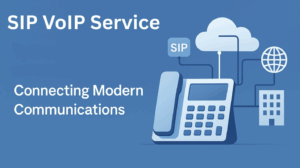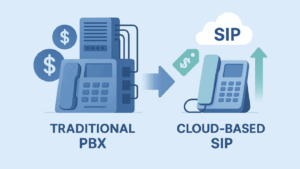
Private and public domain SIP trunking: Find Out What Makes Them So Different
Did you know that as of 2017, more than 65% of businesses were using a SIP trunk?
SIP trunking is becoming increasingly popular with big and small companies that are looking to maximize their communication efforts whilst minimizing their costs.
If you are using SIP trunking or are thinking about using it, then check out our guide on what the difference is between private and public domain SIP trunking.
SIP Definition: What is SIP?
SIP stands for Session Initiation Protocol. SIP is used for establishing telecommunication over the internet.
Essentially, the meaning of SIP allows users to place and receive calls, similar to traditional phone lines. However, a SIP network uses internet technology instead of telephone technology.
SIP has a variety of applications and can allow users to:
- call and receive calls (both video and voice calls)
- hold and attend video conferences
- transfer files
- engage in instant messaging sessions
- and even play multiplayer games.
Voice over Internet Protocol (VoIP) companies use SIP to provide internet-based telephone and streaming services.
Internet Telephony Service Providers (ITSPs) deliver telephone services and unified communications to customers who have SIP-based private branch exchange and Unified Communications facilities.
SIP trunking is virtual so businesses don’t need to get any additional hardware. To get SIP, your business also doesn’t already need to have an existing Private Branch Exchange (PBX), as most SIP providers offer a hosted PBX.
Benefits of SIP
The SIP Trunking Services Annual Market Report, conducted by IHS, found that in 2017 SIP trunking had a worldwide revenue of $3.3 billion in the first half of the year. So, it’s clear to see that many businesses are implementing SIP.
But why should you implement SIP into your business? Below are some of the benefits of SIP trunks and how they can help your business.
1. Flexibility
SIP providers are popular among businesses because they provide more flexibility than traditional phone lines. With SIP you’re able to add or delete lines whenever you need or don’t need them.
This element of flexibility is very attractive for businesses because it means that you are paying for exactly what you’re getting. It means that your business can scale easily.
2. Faster Return on Investment
Unlike most new business technologies, SIP provides your business with a faster return on investment opportunity.
This is because there is no hardware involved with the setup, which means you can use it straight away and there aren’t any upfront costs.
3. Saves Your Business Money
Another benefit of SIP is that it can save your business money. International and national calls can cost your business a lot of money, but with SIP you don’t need to worry about that.
You can also expect to reduce your costs because you won’t have to pay for your phone line. Once your business has set up SIP, the only cost you need to cover is the internet and the SIP provider.
These are just three of many benefits of switching to SIP, learn more about the other benefits of SIP protocol and trunking here.
SIP Concerns and Disadvantages
Some businesses are wary of switching to SIP because they don’t quite understand what it is and how it can benefit their business.
One common concern for businesses who are thinking about switching to SIP is that it will be too expensive. However, that isn’t the case and SIP trunking could save your business up to 90% of what you are currently spending. One way it does this is by lowering your network costs.
Another common concern that businesses have about SIP is that it will be difficult to switch. Again, this is not the case, as SIP providers make it painless and easy to switch and some even offer free trials to try before you buy.
One disadvantage of SIP trunking is that if you lose your internet connection, then you also lose the ability to make phone calls. A lot of SIP providers have this covered and can offer your business a failover internet connection. A failover internet connection ensures that you stay connected even if your main internet service disconnects.
Private and Public Domain SIP Trunking
Now that we’ve covered what SIP trunking is and the advantages and disadvantages, let’s look at the differences in domains.
SIP trunking architecture can partition a unified communications network into two domains.
A Private Domain: a VoIP solution that occurs at a customer’s home or business. The private domain takes advantage of phone and unified communication services.
A Public Domain: a full VoIP access solution to the PSTN/PLMN property and responsibility of the ITSP that provides the phone service.
What is the Difference Between the Two Domains?
These two domains need to be interconnected through a SIP trunk. The interconnection involves specific rules and regulations and the ability to handle some services and protocols that fall under SIP trunking.
The main difference between public and private domains in SIP trunking is the laws and regulations of the two domain types.
The ITSP is responsible for ensuring the protection of the public domain, by:
- tracking traffic
- identifying users
- and implementing lawful interception mechanisms.
Whereas the private domain isn’t subject to constraints of the law and may be the responsibility of the ITSP, the end-user, or of a third party who provides the voice services to the company.
Another difference between the public domain and the private domain is the architecture of each domain.
Each domain has elements that perform the characteristic features requested to that specific domain. The result of which is divided into two levels:
- the control of access (Class 5 Softswitch)
- Network-border elements that separate the public domain from the private domain, implementing ITSP phone security policies (where necessary).
Whilst the private domain consists of three levels:
- Corporate-Border elements that separate the public domain from the private, implementing company security policies
- Central Corporate Switching Node
- IP-PBXs.
What Does This Mean for Your Business?
Due to the nature of using the internet, SIP trunks in both the private and the public domain are subject to cyber-attacks. This means that your business might lose important information or data if your phone system is hacked.
Business owners should carefully consider different SIP providers and the features they offer. SIP providers who are committed to protecting their customer’s information are the best to choose, whether they offer private or public domains.
One way to choose between a private domain and a public domain is to consider what you will be using VoIP for. This will help you to determine which SIP trunking option is right for you.
The public domain offers external regulation, which means should anything go wrong with your SIP trunk, you won’t be to blame for it. Whereas, the private domain isn’t subject to specific regulations.
Things to Consider When Selecting Your SIP Provider
Picking the public domain or private domain is one way to compare the different SIP providers. However, there are many other ways in which you can decide whether a SIP provider is right for your business.
1. Price
Finding the right SIP provider can save your business a lot of money, however, you need to make sure that you choose one who offers you what you need for a good price.
Don’t assume that the cheapest provider is the best. There’s no point paying less for a provider only to find out they don’t offer enough customer support. The good thing about a lot of SIP providers is that they don’t make you commit to lengthy contracts.
2. Customer Support and Technical Assistance
You might also want to consider how much customer support and technical assistance your SIP provider can give your business.
The maintenance of SIP trunks is held by the provider, so it’s vital that they offer exceptional support and can address any issues or problems that your business encounters.
3. Scalability
If your business has big growth ambitions, then you need to be sure that your SIP provider can accommodate this. Most SIP providers ensure that businesses can add new lines and allow businesses to grow as big as they need, but make sure you check before you buy.
Choose a Domain SIP Trunking Option That’s Right for You
Choosing a domain SIP trunking option and a SIP provider that offers your business exactly what you need is very important. You need to make sure that you’re getting the best deal, whilst not scrimping on the safety and security of your business.
Contact us now if you want to find out more about SIP trunking and how to choose the right domain for your business.


